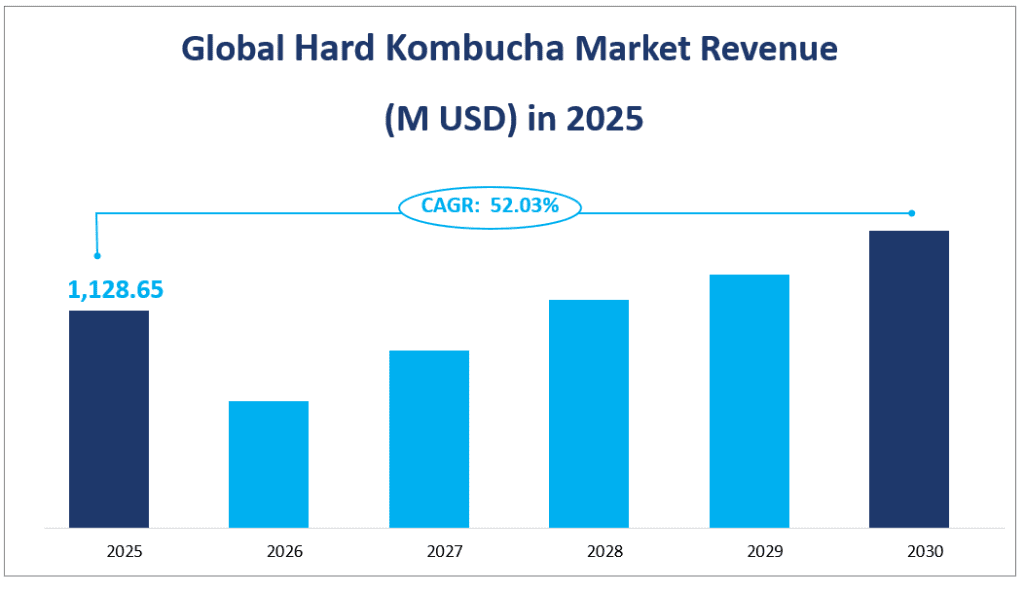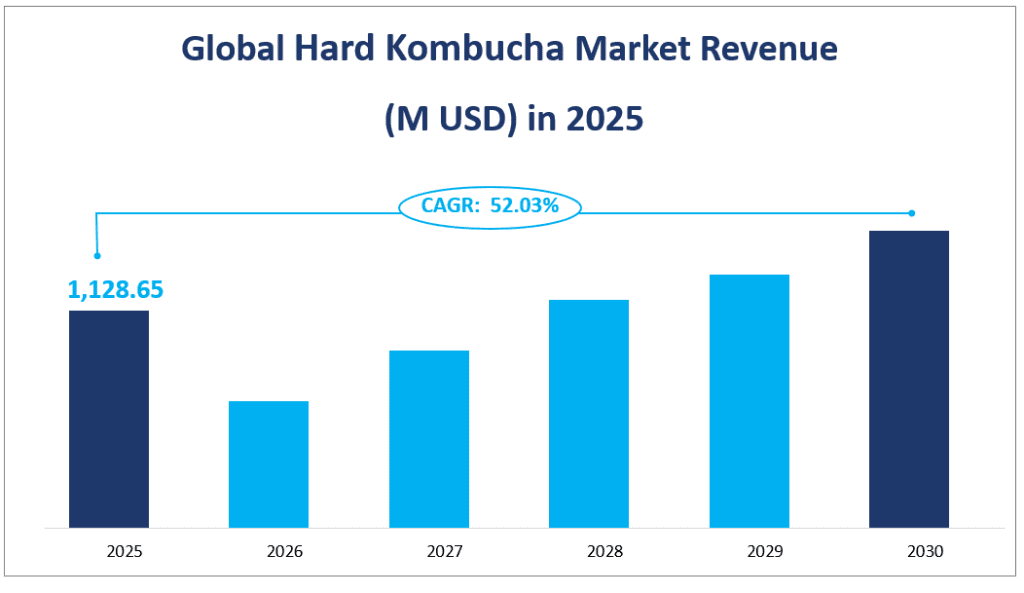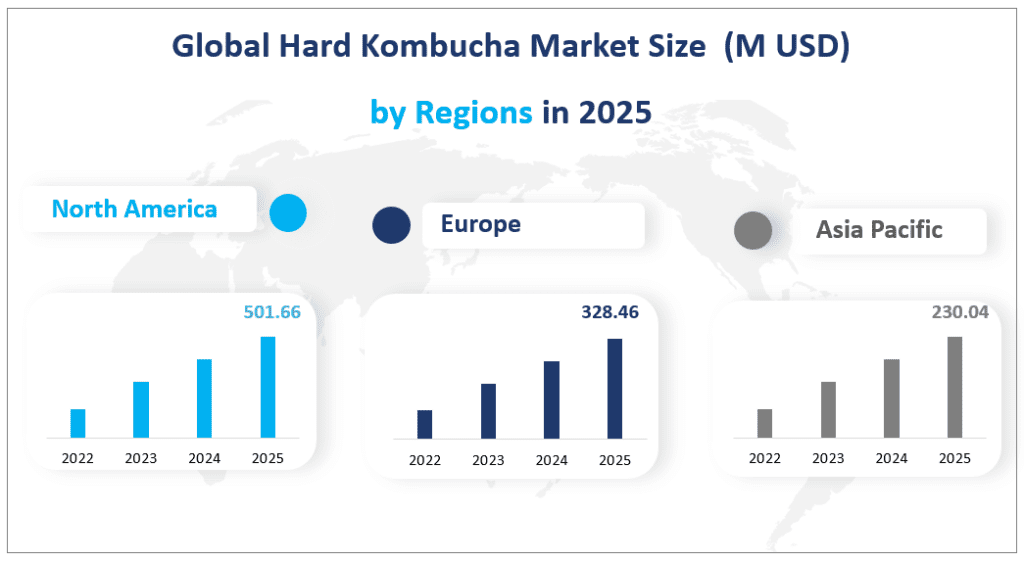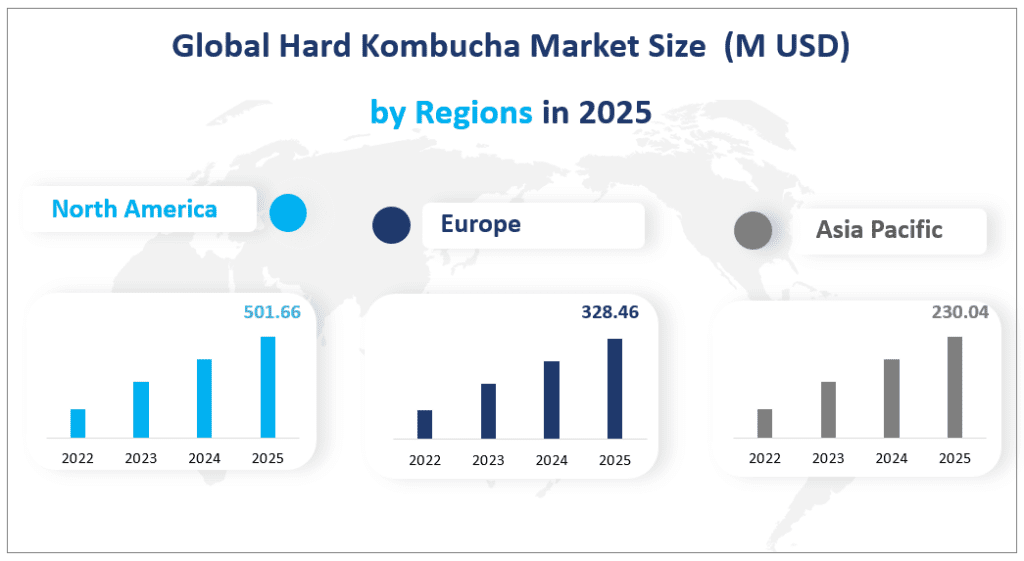1. Global Hard Kombucha Market Definition
The global hard kombucha market is projected to reach a revenue of $1,128.65 million with a CAGR of 52.03% from 2025 to 2030.
The definition of hard kombucha extends beyond its alcohol content. It is a beverage that appeals to health-conscious consumers due to its probiotic properties and natural ingredients. The fermentation process not only enhances the flavor profile but also contributes to the health benefits associated with kombucha, such as improved digestion and immune system support. As a result, hard kombucha has carved out a niche in the broader alcoholic beverage market, targeting consumers who prioritize health and wellness without compromising on taste and enjoyment.
Global Hard Kombucha Market Revenue (M USD) in 2025


2. Driving Factors of the Global Hard Kombucha Market
Health-Conscious Consumer Trends: The primary driver of the hard kombucha market is the growing trend towards healthier lifestyles. Consumers are increasingly seeking alternatives to traditional alcoholic beverages that offer health benefits. Hard kombucha, with its probiotic content and natural ingredients, fits this demand perfectly, attracting a wide range of health-conscious consumers.
Innovation in Product Development: Manufacturers are continuously innovating to meet consumer preferences. The introduction of various flavors, organic options, and lower-calorie versions has broadened the appeal of hard kombucha. This innovation has not only attracted new consumers but also retained existing ones by providing diverse choices.
Expansion of Sales Channels: The rise of e-commerce and direct-to-consumer sales channels has significantly impacted the growth of the hard kombucha market. Online platforms have made it easier for consumers to access these products, while also providing manufacturers with a wider reach beyond traditional retail stores.
Growing Popularity in Emerging Markets: The Asia-Pacific region, in particular, is experiencing a surge in demand for hard kombucha. Countries like Australia, Japan, and South Korea are witnessing increased consumer interest, driven by a combination of health trends and the influence of Western markets.
Supportive Regulatory Environment: Governments in many regions are recognizing the health benefits of kombucha and are providing a supportive regulatory environment for its production and sale. This has encouraged new entrants into the market and facilitated the expansion of existing players.
3. Limiting Factors of the Global Hard Kombucha Market
High Competition: The hard kombucha market is becoming increasingly competitive, with new players entering regularly. This competition can lead to price wars and challenges in market penetration, especially for smaller brands. Established players may also face difficulties in maintaining market share as new competitors offer innovative products.
Regulatory Challenges: While the regulatory environment is generally supportive, there are still challenges related to alcohol content labeling and health claims. These regulations can vary by region, adding complexity for manufacturers and potentially limiting market expansion.
Consumer Perception: Despite its health benefits, hard kombucha is still an alcoholic beverage, and some consumers may view it with skepticism. The perception of alcohol as a less healthy option compared to non-alcoholic beverages could limit its appeal to certain demographics.
Production and Distribution Costs: The production process of hard kombucha involves specific fermentation techniques and quality control measures, which can be costly. Additionally, the need for specialized distribution channels and storage conditions can increase operational costs, potentially affecting profitability.
Economic Uncertainty: Global economic conditions, including trade wars and geopolitical tensions, can impact the hard kombucha market. Fluctuations in raw material prices and supply chain disruptions can affect production costs and availability, limiting market growth.
4. Analysis of Different Product Types of the Global Hard Kombucha Market
Hard kombucha with an ABV of 4.5% or lower is designed to appeal to consumers who prefer a lighter alcoholic beverage. This segment is expected to achieve a market revenue of $201.77 million by 2025. While this type has a relatively lower market share than its counterparts, it still holds significant potential, especially among consumers looking for a more approachable alcoholic beverage.
The 4.5% < ABV < 6% segment is projected to have the second-largest market share by 2025, with a revenue of $350.46 million. This type of hard kombucha is often preferred for its balanced flavor profile and suitability for various social settings, making it a versatile choice for both casual and formal occasions.
The ABV ≥ 6% segment with the highest alcohol content (ABV ≥ 6%) is expected to dominate the market by 2025, with a projected revenue of $576.42 million. This type of hard kombucha appeals to consumers who enjoy a more robust flavor and are willing to experiment with different varieties. The higher alcohol content also makes it a suitable alternative to traditional beers and wines, particularly in social drinking scenarios.
The global hard kombucha market is diverse, with each product type catering to different consumer preferences. By 2025, the segment with ABV ≥ 6% is projected to have the largest market share and the fastest growth rate, driven by its robust flavor profile and versatility. However, the other segments (ABV ≤ 4.5% and 4.5% < ABV < 6%) also hold significant potential, catering to consumers who prefer lighter or moderately alcoholic beverages. As the market continues to evolve, manufacturers will need to focus on innovation and product differentiation to meet the diverse needs of consumers.
Different Applications
The online application segment is projected to achieve a market revenue of $214.63 million by 2025. Online sales provide consumers with the convenience of purchasing hard kombucha from the comfort of their homes, making it accessible to a broader audience. This segment’s growth is driven by the expansion of digital marketing strategies, improved logistics, and the ability to reach consumers in remote areas. The online platform also allows for personalized marketing and direct engagement with consumers, enhancing brand loyalty.
The offline application segment is expected to dominate the market by 2025, with a projected revenue of $914.03 million. This segment includes traditional retail stores, supermarkets, bars, and restaurants, where consumers can purchase and enjoy hard kombucha in a social setting. The offline market’s strength lies in its immediate availability and the sensory experience of purchasing and consuming the beverage in person. This segment is particularly important for new product launches and brand promotions, as it allows consumers to try new flavors and varieties in a tangible environment.
Market Revenue by Segment
| Market Revenue (M USD) in 2025 | ||
| By Type | ABV≤4.5% | 201.77 |
| 4.5%<ABV<6% | 350.46 | |
| ABV≥6% | 576.42 | |
| By Application | Online | 214.63 |
| Offline | 914.03 |
5. Regional Hard Kombucha Market
North America is projected to be the largest regional market for hard kombucha by 2025, with a market value of $501.66 million. North America has been at the forefront of the hard kombucha trend, with early adopters and a robust distribution network. The region benefits from a health-conscious consumer base and a vibrant craft beverage culture, making it an ideal market for hard kombucha products.
Europe is expected to be the second-largest regional market, with a value of $328.46 million. Europe’s market growth is driven by increasing awareness of health benefits and a growing preference for natural and organic products. Countries like Germany, the UK, and France are leading the charge, with a strong presence of both local and international brands.
The Asia-Pacific region is projected to be the fastest-growing market. By 2025, the region’s market value is expected to reach $230.04 million. The rapid growth in Asia-Pacific is driven by emerging markets such as Australia, Japan, and South Korea, where consumer interest in healthier beverages is on the rise. The region’s large population and increasing disposable income provide a significant opportunity for hard kombucha brands to expand their market presence.
The global hard kombucha market is poised for significant growth across all major regions by 2025. North America is expected to remain the largest market by value, driven by its early adoption and strong consumer demand. However, the Asia-Pacific region is projected to be the fastest-growing market, reflecting the region’s potential for expansion. Europe also shows strong growth, driven by increasing health awareness and a vibrant craft beverage culture. As the market continues to evolve, manufacturers will need to tailor their strategies to meet the unique demands of each region, leveraging local trends and consumer preferences to drive further growth.
Global Hard Kombucha Market Size (M USD) by Regions in 2025


6. Top 3 Companies in the Global Hard Kombucha Market
Company Introduction and Business Overview:
Boochcraft is a leading brand in the hard kombucha market, known for its commitment to producing high-quality, organic, and gluten-free beverages. Launched in 2016 in Chula Vista, California, Boochcraft has quickly gained a reputation for its unique flavors and health benefits. The company’s products are characterized by a 7% ABV, combining traditional kombucha fermentation with a robust alcoholic content.
Products Offered:
Boochcraft offers a variety of flavors, including Grapefruit Hibiscus, which features natural ingredients like grapefruits, hibiscus, and raw kombucha. The company’s products are certified organic, vegan, and gluten-free, appealing to health-conscious consumers.
Company Introduction and Business Overview:
JuneShine is a prominent player in the hard kombucha market, known for its focus on organic and sustainable production. Established in 2018, JuneShine has quickly become a favorite among consumers seeking healthier alcoholic beverages. The company’s products are characterized by a balanced flavor profile and a commitment to using organic ingredients.
Products Offered:
JuneShine offers a range of flavors, including Pineapple and Orange, which are made with organic green tea, honey, and other natural ingredients. The company’s products have an ABV of 6%, making them suitable for a wide range of consumers.
Company Introduction and Business Overview:
Flying Embers is a leading brand in the hard kombucha market, known for its commitment to producing organic and functional beverages. Established in 2017 in Ventura, California, the company has quickly gained a reputation for its unique product formulations and health benefits. Flying Embers’ products are characterized by low sugar, low carbohydrates, and the inclusion of live probiotics.
Products Offered:
Flying Embers offers a variety of flavors, including Sea to Sky, which features a 7% ABV and is brewed with adaptogen root blends. The company’s products are USDA-certified organic, vegan, and gluten-free, appealing to health-conscious consumers.
Major Players
| Company Name | Plant Locations | Market Distribution |
| Boochcraft | USA | USA |
| JuneShine | USA | USA |
| Flying Embers | USA | USA |
| Kyla | USA | USA |
| Kombrewcha | USA | USA |
| Nova Easy Kombucha | USA | USA |
| Wild Tonic | USA | USA |
| Unity Vibration | USA | USA |
| GT’s Living Foods | USA | Mainly in North America |
| Luna Bay | USA | USA |
| Strainge Beast | USA | USA |
| K.Booch | Australia | Australia |
| Tura Kombucha | USA | USA |
1 Market Overview
1.1 Hard Kombucha Introduction
1.2 Market Analysis by Types
1.2.1 ABV≤4.5%
1.2.2 4.5%<ABV<6%
1.2.3 ABV≥6%
1.3 Market Analysis by Applications
1.3.1 Online
1.3.2 Offline
1.4 Market Analysis by Regions
1.4.1 North America (United States, Canada and Mexico)
1.4.2 Europe (Germany, France, UK, Russia, Italy and Spain)
1.4.3 Asia-Pacific (China, Japan, South Korea, India and Southeast Asia)
1.4.4 South America
1.4.5 Middle East and Africa
1.5 Market Dynamics and Development
1.5.1 Merger, Acquisition and New Investment
1.5.2 Market SWOT Analysis
1.6 Hard Kombucha Industry Development Trends under COVID-19 Outbreak
1.6.1 Global COVID-19 Status Overview
1.6.2 Influence of COVID-19 Outbreak on Hard Kombucha Industry Development
2 Manufacturers Profiles
2.1 Boochcraft
2.1.1 Business Overview
2.1.2 Products Analysis
2.1.3 Boochcraft Hard Kombucha Sales, Price, Revenue, Gross Margin
2.2 JuneShine
2.2.1 Business Overview
2.2.2 Products Analysis
2.2.3 JuneShine Hard Kombucha Sales, Price, Revenue, Gross Margin
2.3 Flying Embers
2.3.1 Business Overview
2.3.2 Products Analysis
2.3.3 Flying Embers Hard Kombucha Sales, Price, Revenue, Gross Margin
2.4 Kyla
2.4.1 Business Overview
2.4.2 Products Analysis
2.4.3 Kyla Hard Kombucha Sales, Price, Revenue, Gross Margin
2.5 Kombrewcha
2.5.1 Business Overview
2.5.2 Products Analysis
2.5.3 Kombrewcha Hard Kombucha Sales, Price, Revenue, Gross Margin
2.6 Nova Easy Kombucha
2.6.1 Business Overview
2.6.2 Products Analysis
2.6.3 Nova Easy Kombucha Hard Kombucha Sales, Price, Revenue, Gross Margin
2.7 Wild Tonic
2.7.1 Business Overview
2.7.2 Products Analysis
2.7.3 Wild Tonic Hard Kombucha Sales, Price, Revenue, Gross Margin
2.8 Unity Vibration
2.8.1 Business Overview
2.8.2 Products Analysis
2.8.3 Unity Vibration Hard Kombucha Sales, Price, Revenue, Gross Margin
2.9 GT’s Living Foods
2.9.1 Business Overview
2.9.2 Products Analysis
2.9.3 GT’s Living Foods Hard Kombucha Sales, Price, Revenue, Gross Margin
2.10 Luna Bay
2.10.1 Business Overview
2.10.2 Products Analysis
2.10.3 Luna Bay Hard Kombucha Sales, Price, Revenue, Gross Margin
2.11 Strainge Beast
2.11.1 Business Overview
2.11.2 Products Analysis
2.11.3 Strainge Beast Hard Kombucha Sales, Price, Revenue, Gross Margin
2.12 K.Booch
2.12.1 Business Overview
2.12.2 Products Analysis
2.12.3 K.Booch Hard Kombucha Sales, Price, Revenue, Gross Margin
2.13 Tura Kombucha
2.13.1 Business Overview
2.13.2 Products Analysis
2.13.3 Tura Kombucha Hard Kombucha Sales, Price, Revenue, Gross Margin
3 Global Hard Kombucha Market Competition, by Manufacturer
3.1 Global Hard Kombucha Sales and Market Share by Manufacturer
3.2 Global Hard Kombucha Revenue and Market Share by Manufacturer
3.3 Market Concentration Rate
3.3.1 Top 3 Hard Kombucha Manufacturer Market Share
3.3.2 Top 6 Hard Kombucha Manufacturer Market Share
4 Global Hard Kombucha Market Analysis by Regions
4.1 Global Hard Kombucha Sales, Revenue and Market Share by Regions
4.1.1 Global Hard Kombucha Sales by Regions (2015-2020)
4.1.2 Global Hard Kombucha Revenue by Regions (2015-2020)
4.2 North America Hard Kombucha Sales and Growth (2015-2020)
4.3 Asia-Pacific Hard Kombucha Sales and Growth (2015-2020)
5 North America Hard Kombucha by Countries
5.1 North America Hard Kombucha Sales, Revenue and Market Share by Countries
5.1.1 North America Hard Kombucha Sales by Countries (2015-2020)
5.1.2 North America Hard Kombucha Revenue by Countries (2015-2020)
5.2 United States Hard Kombucha Sales and Growth (2015-2020)
5.3 Canada Hard Kombucha Sales and Growth (2015-2020)
6 Europe Hard Kombucha by Countries
7 Asia-Pacific Hard Kombucha by Countries
7.1 Asia-Pacific Hard Kombucha Sales, Revenue and Market Share by Countries
7.2 Australia Hard Kombucha Sales and Growth (2015-2020)
7.3 Australia Hard Kombucha Revenue and Growth (2015-2020)
8 South America Hard Kombucha by Countries
9 Middle East and Africa Hard Kombucha by Countries
10 Global Hard Kombucha Market Segment by Types
10.1 Global Hard Kombucha Sales, Revenue and Market Share by Types (2015-2020)
10.1.1 Global Hard Kombucha Sales and Market Share by Types (2015-2020)
10.1.2 Global Hard Kombucha Revenue and Market Share by Types (2015-2020)
10.2 ABV≤4.5% Sales Growth and Price
10.2.1 Global ABV≤4.5% Sales Growth (2015-2020)
10.2.2 Global ABV≤4.5% Price (2016-2020)
10.3 4.5%<ABV<6% Sales Growth and Price
10.3.1 Global 4.5%<ABV<6% Sales Growth (2015-2020)
10.3.2 Global 4.5%<ABV<6% Price (2016-2020)
10.4 ABV≥6% Sales Growth and Price
10.4.1 Global ABV≥6% Sales Growth (2015-2020)
10.4.2 Global ABV≥6% Price (2016-2020)
11 Global Hard Kombucha Market Segment by Applications
11.1 Global Hard Kombucha Sales Market Share by Applications (2015-2020)
11.2 Online Sales Growth (2015-2020)
11.3 Offline Sales Growth (2015-2020)
12 Hard Kombucha Market Forecast (2020-2025)
12.1 Global Hard Kombucha Sales, Revenue and Growth Rate (2020-2025)
12.2 Hard Kombucha Market Forecast by Regions (2020-2025)
12.2.1 North America Hard Kombucha Market Forecast (2020-2025)
12.2.2 Europe Hard Kombucha Market Forecast (2020-2025)
12.2.3 Asia-Pacific Hard Kombucha Market Forecast (2020-2025)
12.2.4 South America Hard Kombucha Market Forecast (2020-2025)
12.2.5 Middle East and Africa Hard Kombucha Market Forecast (2020-2025)
12.3 Hard Kombucha Market Forecast by Types (2020-2025)
12.4 Hard Kombucha Market Forecast by Applications (2020-2025)
13 Sales Channel, Distributors, Traders and Dealers
13.1 Sales Channel Status
13.1.1 Direct Marketing
13.1.2 Indirect Marketing
13.2 Distributors
14 Appendix
14.1 Methodology
14.2 Research Data Source
